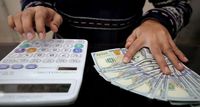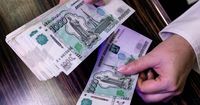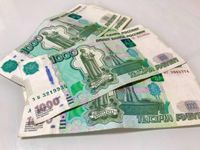The Russian ruble has experienced significant fluctuations in early 2025, raising questions about its future trajectory against major currencies like the US dollar and the euro. On March 26, 2025, the Central Bank of Russia set the official dollar exchange rate at 84.1930 rubles, up from 83.8737 rubles, while the euro was pegged at 92.3409 rubles, an increase from 91.5252 rubles. This strengthening of the ruble, which has appreciated by 17% since the start of the year, has been attributed to a combination of geopolitical developments and economic factors.
According to analysts, the recent rise in the ruble's value can largely be linked to improving relations between Russia and the United States, alongside expectations of a resolution to the ongoing conflict in Ukraine. These factors have spurred speculative foreign capital to enter Russia, drawn by high real interest rates. Alexander Potavin, an analyst, noted, "The significant strengthening of the ruble we observed in February and March was largely due to a number of internal factors. A key one was the expectations of a resolution to the Ukrainian conflict, which would lead to the lifting of sanctions on Russia, attracting speculative foreign capital eager to profit from high real rates."
However, Potavin cautioned that even if political negotiations yield positive outcomes, one should not expect a rapid lifting of external sanctions. He stated, "The removal of sanctions, which everyone is hoping for, will not lead to serious changes in the Russian economy." This sentiment is echoed by other experts who believe that the lifting of sanctions would not automatically translate into economic improvement for Russia.
In fact, the current geopolitical landscape remains fraught with uncertainty. As of late March, the dollar was trading between 82 and 88 rubles, while the euro remained around 90 to 96 rubles. The yuan, meanwhile, was expected to hover between 11.3 and 12.0 rubles. Potavin remarked that with the dollar currently valued at approximately 84 rubles, it has more potential for growth than decline.
Fluctuations in the ruble's value have been stark. For instance, on January 10, 2025, the dollar reached an all-time high of 102 rubles, only to drop to around 81 rubles by mid-March. This volatility has been attributed to the changing geopolitical climate and shifting investor sentiment. Alexander Suetin, an economist, explained that while the dollar's decline may seem beneficial, it could lead to negative repercussions if investor confidence wanes further. He noted, "As soon as investor trust is exhausted, the dollar may not only return to previous levels but exceed them, as positive sentiments could shift to extremely negative ones."
The Central Bank of Russia has been adjusting its methods for determining exchange rates since June 2024, relying on data from credit organizations and off-exchange trading platforms. This change comes amid a cessation of trading currencies from so-called unfriendly countries on the exchange market, which has altered the dynamics of currency valuation in Russia.
Exporters in Russia are feeling the pinch from the stronger ruble, which has made their products less competitive on the international market. Alexander Novak, the Deputy Prime Minister, acknowledged that while a strong ruble can help curb inflation, it poses challenges for exporters. He stated, "We observe volatility; for exporters, this is indeed a negative factor. However, it also plays a positive role in terms of reducing inflation."
The impact of the ruble's strength is particularly pronounced in the metallurgy sector, where companies like Norilsk Nickel and UC Rusal derive a significant portion of their revenue from exports. Vasily Danilov, an analyst, explained that a stronger ruble leads to decreased revenues when converting foreign earnings back into rubles, as many costs are incurred in local currency. He elaborated, "If a company reports in rubles but earns predominantly in foreign currency, the strengthening ruble results in lower revenues due to conversion losses."
The oil and gas sector, a cornerstone of the Russian economy, is also grappling with the ramifications of a stronger ruble. Recent statistics from the Ministry of Finance revealed an 18.4% year-on-year decline in direct rental collections from the oil and gas sector, amounting to a loss of 174 billion rubles. Analysts predict that if the ruble continues to appreciate, it could lead to reduced investments in production and modernization, further straining the sector's profitability.
In the gold mining industry, the strengthening ruble is similarly problematic. While gold prices have surged by 15.2% since the beginning of the year, the ruble's appreciation has diminished the revenue from exports, as the costs of production remain largely in rubles. Oksana Lukicheva, an analyst at UralSib, pointed out that while the sector remains resilient due to high global gold prices, the ruble's strength necessitates companies to optimize costs and possibly revise their development plans.
Maxim Khudakov, a strategist at Vector Capital, highlighted the dire situation in the coal industry, where several enterprises have already closed due to the compounded effects of falling global prices and a stronger ruble. He remarked, "We are already witnessing the closure of nine coal enterprises in the Kemerovo region due to the unstable situation in the market."
Looking ahead, experts suggest that the current strengthening of the ruble may not be sustainable. Many believe it is driven by speculative factors tied to geopolitical events rather than fundamental economic improvements. Stanislav Mitrakhovich, an expert from the Financial University, posited that the government may need to consider a controlled depreciation of the ruble to stabilize the economy and meet budgetary obligations. He warned, "If we have seen a decline in oil and gas revenues by nearly a fifth, this is a serious issue, and we need to find ways to compensate for it."
In summary, while the ruble's recent strength may offer some short-term benefits in terms of inflation control, the long-term implications for exporters and the overall economy remain uncertain. The interplay between geopolitical developments, investor sentiment, and internal economic policies will be crucial in determining the ruble's future trajectory.








